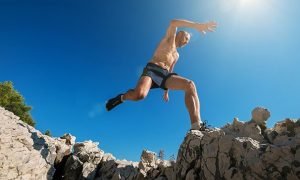THE NATURAL TRAINING:
for a physical revolution:
Nature is a guide
Jumping, running, climbing, lifting, throwing… Our ancestors, but also our children, develop instinctively through these natural movements. Their goal: to become a strong and efficient human being.
Our body and our brain have evolved through and for movement, in a complex natural environment. Our development will be optimal if we cultivate this innate ability.
At the time of aesthetic fitness, performance sport, and air-conditioned rooms, we offer you another way of seeing physical training:
Move naturally, develop your potential, get closer to nature and YOUR nature.
(photo)
Our training method is based on the range of biologically natural human movements: walking, balancing, running, jumping, crawling, climbing, swimming, wrestling, kicking, lifting, carrying, throwing, catching. Our goal is to regain our original strength and health.
Our vision of progress is also natural: we train within the limits of our possibilities, and we push our limits in a playful and benevolent atmosphere. Everyone can develop their potential in this way, regardless of their initial level.
This approach to authentic human movement, undisturbed by a demanding sports technique, makes it a tool increasingly appreciated not only by sports educators, but also by physiotherapists, osteopaths, naturopaths.
(button to principles)
A method proven by history
Let’s be clear, it is not a question of a return to the wild life, but of finding a physical activity adapted to our nature, oriented towards practical and useful efficiency.

Georges HÉBERT
At the beginning of the 20th century, a naval officer noted that many “primitive” peoples had higher physical performance than his soldiers. He proposed to replace bodybuilding and Swedish gymnastics with more natural gestures close to their concrete needs. All armies used (and still use) this method. From the army, he then adapted it to the general public.
His name : Georges Hébert
His ambition: That each and everyone finds his full physical potential.
His method: Use natural, useful, effective gestures for optimal development. It is the origin of the principles of modern functional training.
Georges Hébert called it the “Natural Method”, history also called it “Hébert Method” or “Hébertisme”.
We call it today THE NATURAL TRAINING
(bouton “en savoir plus sur l’histoire”, vers la vie de Georges Hébert))
Natural training, a complete experience
Beyond a simple physical practice, the Hébert Method is intended to be a real education, through the development of practitioners on 3 axes: (bouton en bas vers les principes)
Develop
|
Strengthen
|
Cultivate
|
| Develop your courage, your coolness, your will, by confronting real (but controlled) situations and challenges. Better know your capacities, your limits, and know how to increase them. Develop your energy, your sense of action, by emulating collective training. |
| La poursuite de ces objectifs est résumée dans la devise : ETRE FORT POUR ETRE UTILE, A SOI-MEME ET AUX AUTRES |
Find a trainingTo discover, train for yourself or for others by becoming an instructor, follow the training courses: |
 |
 |
Find a center or a monitorTo discover and practice, whatever your age and level, to rediscover the joy of moving naturally, look for the hébertiste center (associative environment) or the coach (independent) closest to you. |




